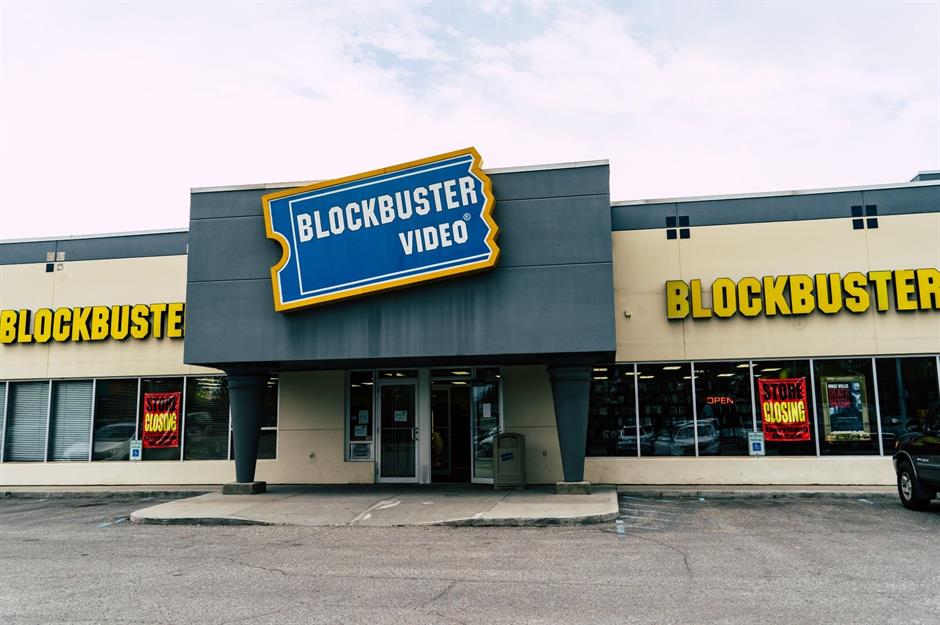||

If you were born in the ’80s or ’90s, chances are you’ve heard of Blockbuster. The company was a household staple through its movie and video game rental services. The rental giant brought the idea of premier on-demand entertainment to life with hundreds of DVDs, video games, candy, and membership cards. Blockbuster peaked with earnings of 5 billion dollars in 2004; however, it quickly found itself being forced to shut down a year after due to an outdated platform for DVD rentals and late fees.
Business Origins
The business was originally started by David Cook, a local entrepreneur and software developer from Texas. Cook found the need to open Blockbuster as many movie and video game rental companies in the area had a reduced inventory and limited amount of titles to offer the public. He aimed to fix this problem through creating the first super brand in the video rental industry. In 1985, Cook sold the company to Wayne Huizenga and two other investors who pooled in funds to restart the business. In the same year, Blockbuster went public with an IPO (initial public offering) of 31 million shares for 18% of the company. Huizenga went on to own many Fortune 500 companies, including Waste Management and AutoNation. He also had a stake in South Florida sports teams such as the Florida Panthers and Miami Marlins. In 1994, Huizenga sold the company to Viacom, a media conglomerate, who bought Blockbuster for $8.4 billion.
The Rise
The company found early success with a large inventory storing over 8000 tapes, covering 6500 titles. Blockbuster grew quickly by offering quick check-out times and a wide selection of entertainment options. In 1987, they found themselves as the country’s 5th largest video rental store with over $43.2 million in revenues. In 1988, Blockbuster became the leading brand for on-demand entertainment with 800 stores. In 1992, Blockbuster bought the video rental company Ritz and spread out to over 1000 stores. To gain publicity, Blockbuster operated a 25 million dollar ad campaign along with partnerships with fast-food giants such as McDonalds and Dominos. The company broke the charts in the early 2000s with 60,000 employees and 9,000 stores worldwide.
Ideation and Business Model
Blockbuster’s business model revolved around late fees in their movie and video game rental services. Blockbuster charged a dollar per day in late fees if a customer didn’t return their movies on time. Late fees remained a hallmark memory for recurring customers and a primary source of income in the early 2000s. The fees raked in $800 million dollars in 2000, which was worth about 16% of Blockbuster’s revenue that year. Blockbusters’ customer-centric model utilized a low upfront cost and a higher variable cost to appeal more towards the customer. Their model, however, ignored the idea of charging a flat fee for products which Netflix quickly took advantage of. Netflix charged a fixed price for renting their products and virtually removed the premise of a late fee. They also rolled out an online subscription service, which revolutionized the renting business scheme. In addition, Blockbuster overlooked the huge business opportunity when given a chance to buy Netflix in 2000 for $50 million. All of these events soon led to Blockbuster’s downfall.
The Fall
While finding themselves at their peak in the early 2000s, Blockbuster had newfound competitors in the likes of Netflix and Redbox. Blockbuster soon became outdated with the idea of DVD rentals by mail and a flat rate with no late fees. In 2002, Netflix had reached the markets with a public offering worth $95 million. In 2006, Netflix had passed Blockbuster in yearly revenue: earning $80 million in profits. By 2007, Netflix had released its on-demand streaming services and the ideas of in person DVD rental soon vanished. Their outdated business model, coupled with billions in debt that Blockbuster carried from their prior ownership with Viacom, had forced Blockbuster to shut down. In 2010, Blockbuster found itself forced to file for bankruptcy.
Conclusion
For a company that was once advanced for its times, Blockbuster simply couldn’t adapt to the changing times in on-demand entertainment. Clearly, the tale of Blockbuster teaches the essential ideas of adaptation and the importance of change in the world of business. Many companies have fallen due to not being able to adapt. We can turn our eyes to the camera company Kodak which was unable to adapt to the world of instant photography and polaroid cameras. Their company lost billions from this mistake and were soon undercut by Fuji, a Japanese conglomerate. As best put in the words of Charles Darwin: “It is not the strongest species that survives, nor the most intelligent that survives. It is the one that is most adaptable to change.”
||
---------------------------
By: Vyom Mishra
Title: The Riveting Rise and Fall of Blockbuster LLC
Sourced From: streetfins.com/the-riveting-rise-and-fall-of-blockbuster-llc/
Published Date: Wed, 22 Jun 2022 18:45:58 +0000
Read More
Did you miss our previous article...
https://peaceofmindinvesting.com/clubs/students-get-discounts-on-news-music-and-streaming-services-in-2022
.png) InvestingStocksToolsClubsVideosPrivacy PolicyTerms And Conditions
InvestingStocksToolsClubsVideosPrivacy PolicyTerms And Conditions
